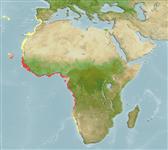Classification / Names
Common names from other countries
Main reference
Size / Weight / Age
Max length : 40.0 cm TL male/unsexed; (Ref. 57392); common length : 24.0 cm FL male/unsexed; (Ref. 3195); max. published weight: 1.5 kg (Ref. 27584)
Environment
Marine; brackish; demersal; depth range 20 - 100 m (Ref. 4233), usually ? - 60 m (Ref. 57392)
Climate / Range
Subtropical, preferred 25°C (Ref. 107945); 39°N - 28°S
Distribution
Eastern Atlantic: Portugal to South Africa, including Madeira and Cape Verde. Replaced by Selene setapinnis in western Atlantic. These two species have not been adequately studied and may prove to be conspecific.
Countries | FAO areas | Ecosystems | Occurrences | Introductions
Short description
Dorsal
spines
(total): 9;
Dorsal
soft rays
(total): 23-24;
Anal
spines: 1-3;
Anal
soft rays: 18 - 20. Diagnosis: body short, deep (depth comprised 1.7-2.3 times in fork length) and strongly compressed; head with a typical hump above eyes and a steep frontal profile that is slightly concave in front of eyes; lower jaw prominent; 2 dorsal fins, 1st with 8 spines that are very short in adults, 2nd with 1 spine and 23 or 24 soft rays; anal fin with 2 anterior detached spines (resorbed in adults), followed by 1 spine and 18-20 soft rays; anterior lobes of soft dorsal and anal fins small or indistinct; pelvic fins very short, nearly rudimentary; body (except breast) entirely covered with minute cycloid scales embedded in the skin; lateral line distinctly arched over pectoral fins, with some weak scutes on the straight posterior part; 2 lateral keels at base of caudal fin (Ref. 57392). Silvery with faint dusky opercular spot; juveniles with oval black spot over straight lateral line (Ref. 3197).
Coloration: entirely silvery with bluish reflections that are more pronounced on dorsal half; a blackish spot at upper angle of gill cover; in juveniles, another blackish spot on sides of body, at the inflexion point of the lateral line; fins hyaline (Ref. 57392).
IUCN Red List Status (Ref. 115185)
Threat to humans
Harmless
Human uses
Fisheries: commercial
More information
ReferencesAquacultureAquaculture profileStrainsGeneticsAllele frequenciesHeritabilityDiseasesProcessingMass conversion
Tools
Special reports
Download XML
Internet sources
Estimates of some properties based on models
Phylogenetic diversity index
PD50 = 0.5039 many relatives (e.g. carps) 0.5 - 2.0 few relatives (e.g. lungfishes)
Trophic Level
4.1 ±0.69 se; Based on food items.
Resilience
High, minimum population doubling time less than 15 months (K=0.6)
Vulnerability
Low vulnerability (25 of 100)
Price category
